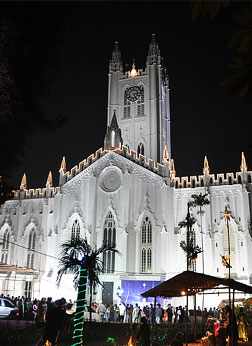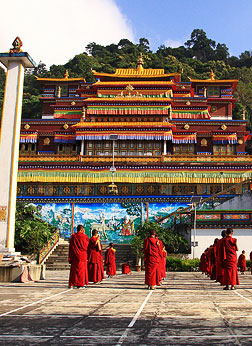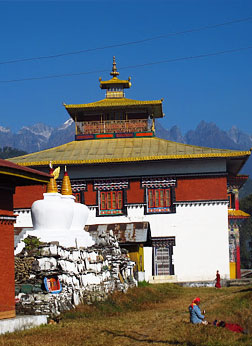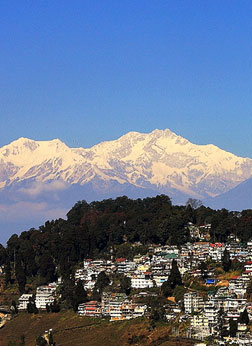Day 1 : Arrive Kolkata
Arrive Kolkata and than transfer to hotel.
Kolkata was the capital of India during British emperor. The city's documented history, however, begins with the arrival of the English East India Company in 1690, when the Company was consolidating its trade business in Bengal. Job Charnock, an administrator with the company was traditionally credited as the founder of the city. In 2003 high court order states that the city should not have a specific founder. While the city's name was always pronounced "Kolkata" in the local Bengali language, its official English name was changed from "Calcutta" to "Kolkata" in 2001, reflecting the Bengali pronunciation.
Then proceed for sightseeing of Kali Temple.
 St. Paul's Cathedral
St. Paul's Cathedral
- Kolkata
There after visit Victoria Memorial, St. Paul Cathedral Church and Mother Teresa's House.
Victoria Memorial - The Victoria Memorial (closed on Monday) is one of the popular tourist attractions in Kolkata. It is a majestic structure which is made with white marble. The structure was constructed during the British Empire in the memory of Queen Victoria. Hundreds of tourists who visit Kolkata come to the Victoria Memorial.
The Victoria Memorial, Kolkata was designed by renowned architect Sir William Emerson. The style of the building is similar to the Belfast City Hall. The structure is constructed with a blend of Mughal and European architectural styles. There is also a museum in the Victoria Memorial which consists of various specimens of ancient Kolkata and also of various artifacts of British India.
St. Paul Cathedral Church - Built between 1839 and 1847, St Paul's Cathedral is one of India's most important churches. It's east of the Victoria Memorial at the South end of the Maidan. The steeple fell during an earthquake in 1897 and was redesigned and rebuilt. Inside there's some interesting memorials and stained glass, including the west window by Sir Edward Burne-Jones.
Overnight at Kolkata.
Day 2 : Kolkata - Bagdogra
Morning in time transfer to airport to board flight for Bagdogra.
Depart Kolkata at 1040 hrs by 6E 503 (Indigo Airlines)
Arrive Bagdogra at 1145 hrs and drive to Gangtok ( Approx. 125 Kms/ 5 hrs drive).
Gangtok : At an altitude of 1750m, Gangtok became the state capital in the mid-19th century and has undergone rapid development since then.The downtown area is dominated by huge government buildings decorated with traditional Buddhist symbols. Gangtok is also a resting ground for people traveling to North Sikkim. Surrounded by Monasteries and Orchids, Gangtok is truly a travellers delight.
Overnight at Gangtok
Day 3: Gangtok
Morning proceed to visit Rumtek monastery.
 Rumtek Monastery - Sikkim
Rumtek Monastery - Sikkim
Rumtek Monastery : 24 Kms. from Gangtok is the awe inspiring Rumtek Monastery the world Dharma chakra Centre and the seat of His Holiness, the Gyalwa Karmapa, who is the head of the Kagyupa order of Tibetan Buddhism. Behind the main monastery is the lavishly decorated Karmae Nalanda Institute of Buddhist Studies, which attracts students from the world over. Opposite the entrance to the Institute is a small hall featuring a beautiful jewel studded Chorten the Golden Stupa, which contains the ashes and remains of His Holiness the xvi Gyalwa Karmapa. According to legend, it is believed that after years of meditation, the first Karmapa was said to have been visited by ten thousand fairies who came to congratulate him each of whom offered a strand of her hair as a gift. These were said to have been woven into a black hat, which was passed down and is still at the Rumtek Monastery today. It is said that unless held on to by the wearer (who of course, cannot be anyone else but the Karmapa) or kept in a box,the hat would fly away.
Then visit Enchey Monastery, Do-drul chorten, Tibetology and orchidarium. In the evening visit Handicraft center and Bazaar.
The Enchey Monastery : Perched on a ridge above Gangtok, the Enchey Monastery is nestled within lush woods with a spectacular view of Gangtok town. Built in 1910 on the site of the hermitage of the great tantric saint, Lama Drutob Karpo, who was renowned for his powers of levitation, this monastery houses the monks of the Nyingmapa Order of Tibetan Buddhism.
Namgyal Institute Of Tibetology (closed on Sundays) : Amidst a serene surrounding of oak, birch and ash lies the unique organization established in1958. Built in traditional style, the namgyal Institute of Tibetology promotes research in Mahayana Buddhism and the language and tradition of Tibet. It has one of the world's largest collections of rare books and manuscripts on Mahayana Buddhism. The Institute also has a retail outlets where related books and commercially produced religious art and craft of Tibet can be bought.Adjacent to the institute are two exquisite stupas, the Do Drul Chorten, built to commemorate the victory of good over evil and the Jhang Chub Chorten, built in the memory of Thrukshik Rinpoche, an ardent devotee, a great spirtualist and interpreter of Buddhism. Near the Chorten are housed two giant statues of Lord Buddha and Guru Padmasambhava, also known as Guru Rimpoche, the patron saint of Sikkim.
Directorate Of Handloom And Handicrafts (Closed on Sundays) : This Directorate was set up to promote traditional Sikkimese art and handicrafts. Exquisitely carved wooden friezes, intricate bamboo work, along with beautiful hand woven carpets and handlooms are on exhibit here. Visitors can not only purchase these items here but also see the artisans at work. Among others, a favourite item here is the choktse a wooden table with carved panels that can be folded into a portable pack.
Overnight at Gangtok.
Day 4 : Gangtok
Full day excursion to Phodong Monastery ( Approx. 40 Kms one way).
Phodang Monastery was built in the 18th century by Chogyal Gyurmed Namgyal. It belongs to the Kargyupa sect. The original monastery has been rebuilt although the old mural paintings and frescoes were preserved. It celebrates its annual 'chaam' on the 28th and 29th day of the tenth month of the Tibetan calendar.
After visiting the monastery come back to Gangtok.
Overnight at Gangtok.
Day 5 : Gangtok - Pelling
Morning after breakfast drive to Pelling via Tashiding Monastery ( Approx. 153 Kms/ 7 hrs).
 Tashiding Monastery - Tashiding
Tashiding Monastery - Tashiding
Tashiding is a small village on a hilltop near Pelling. The Tashiding monastery belongs to the Nyingmapa order and is highly revered among the people of Sikkim. Build on the top of the hill and looming over the Rathong and Rangit river, the monastery can be seen from far and wide.It is believed that even a slight glimpse of the monastery can cleanse mortals of all sins. The monastery was built during the 17th Century.
Inside the monastery, a pot of holy water is kept sealed only to be revealed and its droplets given to devotees once every year at the Bumchu Festival during the 14th and 15th day of the first month of the Tibetan calendar.
Overnight at Pelling.
Day 6 : Pelling - Darjeeling
In the morning visit Pemayasnste Monastery and Rubdanese ruins.
Pemayangtse or Pelling is situated in West Sikkim at Gyalshing, about 140 kms. from Gangtok at an altitude of 2085 meters. Pemayangtse literally means the "Perfect Sublime Lotus" and was built during the reign of the third Chogyal Chador Namgyal in 1705. Pemayangtse is the Sikkim's second oldest monastery, situated near the start of the Dzongri trek. There are beautiful views of Kanchendzonga range from Pemayangtse. Pelling or Pemayangtse is nominally divided into Upper, Middle and Lower areas, though these effectively merge.
Rabdentse is the 16th former capital of Sikkim and now lies in ruins. It was destroyed after the Nepalese invasion in the 18th century. Located close to the Pemayangtse Monastery, the ruins offer superb views of the Kanchenjunga Range.
Afternoon transfer to Darjeeling via Namchi visiting Samdruptse in Solophok ( Approx. 110 Kms / 6 hrs drive). Arrive & check in at hotel.
Darjeeling : Standing high in the Himalayas at an altitude of 2134m, 'Dorje Ling', or place of the Thunderbolt, offers breathtaking views of snow-capped mountain peaks, with the Kanchendzonga rising higher than all the others. Often referred to as the "Queen of the Hills", it remains just as alluring with its tiny waterfalls, little villages and a narrow gauge railway track. Surrounded by World Famous Tea Gardens and snow capped mountains, Darjeeling remains one of the most exotic destinations. Graeme Westlake in his book ' An introduction to hill stations on India' refers to Darjeeling as having "A view Scarcely Unrivalled on Earth".
Afterwards, we drive to Tukvar Tea Estate which is 12 kms from Darjeeling . Here we can witness the entire process of the making of Darjeeling tea. Later take a walk relaxed stroll on the Chowrasta (Main Local Market Street).
Overnight at Darjeeling.
Day 7 : Darjeeling
Early morning visit Tiger Hill and Ghoom Monastery.
 Mt. Kanchenjunga from
Mt. Kanchenjunga from
- Darjeeling
Tiger Hill : It is 13 kms from Darjeeling and one can see beautiful sunrise and Himalayan Range like Kanchandzonga , Mount Everest etc. One can see the horizon changing colors just before sunrise and then the entire Himalayan range turn golden. It is truly a majestic sight.
Ghoom Monastery : This is oldest Monastery in the area which was built in 1875 and one can see the image of Mythey Buddha 15ft. height on the way back from Tiger Hill.
Breakfast at the hotel and go for Enjoy toy train ride.
Toy Train : The spectacular landscape unfolds as the 2-foot gauge Darjeeling Himalayan railway, opened in 1881, labours at about 10 mph criss-crossing the road. It has tiny 4-wheel locomotives (some over 100 years old) like living legends. One can experience the sound, smell and romance of a bygone era. DHR is a work of genius and technological achievement of 1881. It has social and cultural importance. It is beautiful and has outstanding universal appeal. Based on its unique features, it is considered to be of lasting significance to mankind.
Afternoon visit Himalayan Mountaineering Institute (closed on Thursday), Zoological Park(closed on Thursday) and Tibetan Refuge Centre(closed on Sunday).
Himalayan Mountaineering Institute (closed on Thursday) and Padmaja Naidu Himalayan Zoological Park (closed on Thursday) are located on Birch Hill are the major attractions for the tourists some exotic breeds of high altitude fauna such as Siberian tigers, black bear, red pandas, and the elusive Snow Leopards and many colourful Himalayan birds grace the location which is must in the itinerary of all tourists.
The Himalayan Mountaineering Institute was started in Darjeeling when Tenzing Norgay climbed Everest to give training to learn Mountaineering and other adventure sports related to mountaineering and in that Institute one can see equipment etc.used by Mr. Tenzing Norgay and Everest Museum having complete details on Everest attached to institute one can visit Himalayan Zoological Park where one can see Himalayan animals like Snow Leopard, Tibetan Wolf, Tibetan Yak, Himalayan Black Bear and several varieties of birds.
Tibetan Refuge Centre - On Lebong road gives a very good insight into the making of different handicrafts.
Overnight at Darjeeling.
Day 8 : Darjeeling - Bagdogra
After morning breakfast in time transfer back to the Bagdogra airport (80km/3 hours) to board your flight to Kolkata and then connect flight back home.